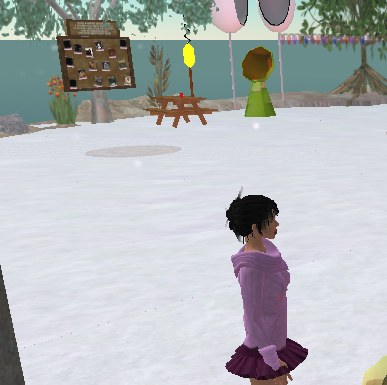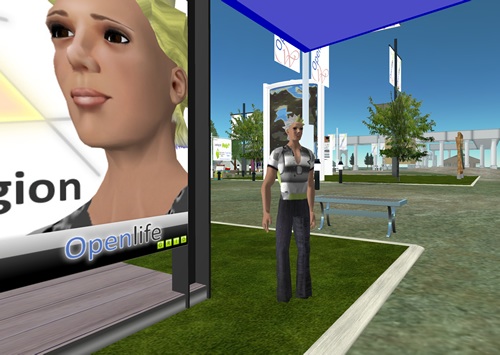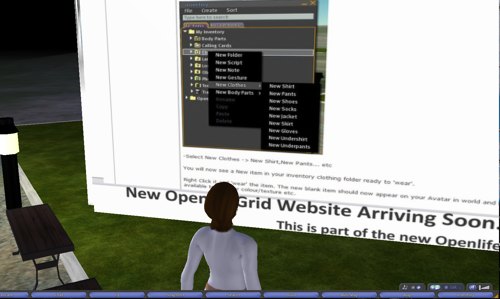1. Play Golf in Hollywood Sim
2. Rollin And Tumblin – Quinton Whitman (live)
3. Silent In The Sanctuary Second Life Events
Tech -- Culture -- Humour
1. Play Golf in Hollywood Sim
2. Rollin And Tumblin – Quinton Whitman (live)
3. Silent In The Sanctuary Second Life Events
On Tuesday 19th February, Luna Park will play host to the Enterprise 2.0 Executive Forum. Hosted by Ross Dawson’s Future Exploration Network, this is a forum where Australian business will hear about the innovations occurring with Web 2.0 and virtual worlds like Second Life.

Yours truly is attending as a media partner for the event and I’m looking forward to discussing with attendees both the challenges and opportunities that virtual worlds provide. If you run a business that’s interested in innovation, it may be worth investigating a late registration for this event.
So why is Luna Park the perfect venue? In the lead-up to next week I was interviewed by Des Walsh from the newly launched Social Media Show. We talked on everything from business interest in virtual worlds to a 3D walkthrough of a human testicle in Second Life – but one point I made was that Luna Park was a metaphor for how businesses tend to see virtual worlds as a game. The reality is a lot different and event’s like next Tuesday’s will help to bring clarity to the issue.
If statistics and charts are your thing then you’ll love this site which provides a roundup of everything MMOG from a metrics viewpoint. Any business wondering whether there’s a market in virtual worlds need only spend a few minutes looking at the graphs to get a pretty clear answer…
Last week, text-to-speech company Cepstral announced they’d formed a partnership with virtual world IMVU to supply text-to-speech capability.

Text-to-speech has huge potential in the virtual world context and is a feature Second Life users have been wishing for. We caught up with Cepstral’s CEO, Craig Campbell, to get a little more detail:
Lowell: What was the impetus for the Cassiopeian / Cepstral partnership?
Craig: Cepstral has a great deal of experience in the traditional Text-to-Speech marketplace, such as Interactive Voice Response (IVR) units. You know, the systems that allow you to call in to your bank and check the balance in your checking account, that sort of thing. However, one of Cepstral’s strengths has been our ability to create lots of interesting voices, not just the same old “your account balance is….” type of voice. We realized that fast-growing consumer web applications might benefit from Text-to-Speech (TTS) if it were simple to use and the voices had personality, such as the ones we’ve created.
IMVU interested us as a very popular Virtual World. Furthermore, they have an established digital goods marketplace. We wanted to enable an application within IMVU, and Cassiopeian is one of the most popular developers in IMVU. Her products are very professional and have a great reputation among IMVU users. When we approached Cassiopeian, they were very interested in adding voice capabilities to IMVU avatars, and have been a pleasure to work with.
Lowell: Is there any plans for providing the same technology in other virtual worlds like Second Life?
Craig: We’re definitely evaluating where to deploy the technology next. We’re looking at other virtual worlds, as well as other online environments. For example, we’re testing a Facebook application – VoicePoke – that allows users to send interesting messages to each other. Through a mash-up with Google’s translation service, the widget can even speak the message in different languages. We think this creative approach to using speech in web applications has a lot of room to grow; be it real-time surrogate voices for virtual worlds, messaging on social networks, or media shifting activities such as converting blogs and web text to a mobile, eyes-free audio format.
Our tagline is – “VoiceForge, We Make the Internet Talk™†– I share this to point out that we are not application developers, but rather the heart of speech on the Internet. We offer a free API that any virtual world or developer can incorporate. Our Software as a Service (SaaS) model means that developers needn’t ramp any hardware or bandwidth or linguistic knowledge in order to quickly embed a large-scale TTS feature inside their applications.
Lowell: Linden Lab have stated they’re working on the ability for people to morph their voices on the fly – will Cepstral always be focused on text-to-speech or do you see opportunities in live voice morphing?
Craig: Voice morphing technology will be an option that some users will use, as an alternative to using their real world voice in chat. But if you look at why people don’t like using their real world voice, there are four reasons: it suspends the fantasy notion of the character, for anonymity, for gender bending, and for non-native English speakers who may be able to type better than they can speak. We think that Cepstral’s Text-to-Speech solves those issues better than voice morphing. A user with voice morphing still hears their own voice, reducing the fantasy of their avatar; the user can often still be identified; a male voice with a higher pitch is not a female voice; and voice morphing does nothing for non-native speakers.
Of course, traditional Text-to-Speech doesn’t solve those problems, since most vendors offer one or two male and female voices. Cepstral’s differentiator is that we offer over 30 voices today, and we’re adding more. And those voices each have a distinct sound and personality. There’s a male Texan voice, a female British voice, and female African voice, a male Brooklyn voice, even a voice called “Damien” that sounds demonic. The user can select the voice that they want for their avatar, much like they select the clothes for their avatar – to match their avatar’s personality.
Lowell: What further developments in text-to-speech do you see occurring in coming years?
Craig: Cepstral is focusing on adding new voices, to give users more options. We have many new voices in the pipeline and foresee hundreds if not thousands of unique voices in the future. We have an alpha version of a tool that allows users to create their own custom voices called the VoiceBankâ„¢. And we’ll continue to improve the quality of the voices so that they sound even more natural.
What are your thoughts? Text-to-speech really appeals to me – is it something you’d use over voice morphing or standard voice chat?
Three mini stories in one today:
1. Ad farms are the target of the latest Linden Lab crackdown. There’s likely to be widespread praise for this move.
2. Second Life’s ABC Island is having a Valentine’s Day event:
“Bring your sweetheart or come and make new friends, or both! Celebrate Valentine’s Day (Thurs 14 Feb TODAY!) at ABC Island at 8pm AEDT on the ABC Park ice rink, near the Sandbox, or roller skate around the ‘ABC logo’ path. Join the Valentine Heart Hunt! Free skates available, or bring your own trick skates”.

3. We received this short missive this afternoon:
“I’m doing research on second life addiciton, it would be a great help if people would take a survey I set up
Al the details here. Do have a good read of the specific system requirements, as your PC’s video card may still be the primary cause of any issues.
We interviewed Logan Linden AKA Australian Chris Collins on his work with Linden Lab.
As we reported earlier this week, Openlife is a promising new alternative grid to Second Life. Its founder, Sakai Openlife (RL: Steve Sima) is based in Brisbane and we caught up with him via Openlife’s Live Chat for a discussion on everything Openlife.

Lowell: Sakai – Openlife came out of the blue for me but it’s obviously been a labour of love for you – can you give a potted history of how Openlife came to be?
Sakai: Sure, we kicked things off approximately four months ago and clearly had to do a lot of work to understand a workable solid method to approach it. Number one has always been and will be the Users. So with this in mind it has been quite a colourful ride trying to foster the community together and maintain the best user experience we can with the code available.
Lowell: what made you start this huge undertaking?
Sakai: Well, I’ve had a passion for 3D interactive platforms for ages and my background is IT infrastructure. So to provide a solid platform being feature rich and extensive for different uses is most certainly up my alley. After following the OpenSimulator project for a while I took the decision to make the plunge and start treading the water with the OpenSim Application Platform – Second Life had some big drawbacks for me.
Lowell: I’m assuming you’ve used Second Life extensively prior to this project? What was it about Second Life in particular that you wanted to improve on?
Sakai: Some towards content creation and development of content and some towards the user experience. Second Life itself I see has been hugely popular with its social interaction and it’s a great environment to see this in action. They have been pioneers in this area for years but to have an open source platform where as a company you could develop very feature rich immersive environments and provide them to users is something that Second Life falls short on in my opinion, but the potential for this to happen with the Openlife Grid & OpenSimulator Codebase is very much a possibility.
Lowell: What areas do you specifically see Openlife having advantages in?
Sakai: One thing we are keen to see in the near future is the ability to content create and develop a region on your local environment ie. home PC or workplace network then export that entirely to a published region existing in the Openlife Grid.
Lowell: So, fully offline region-wide content creation?
Sakai: Correct, exciting isn’t it. This can bring in the quality of in-world environments to a whole new level.
Lowell: I can see that would get a lot of people excited – is that option close?
Sakai: Yes it is close, currently we can take the terrain and prims created. Clearly there are other things to bring over such as textures, scripts etc.
Lowell: So for the sake of the potential new user – is Openlife in beta at present or a fully functioning option?
Sakai: No it is not a fully functioning option at the moment. We work closely with, and implement the Opensimulator source code which in itself is only recently version 0.5. However, community interaction and involvement in the Openlife Grid is important as the code moves forward.
Lowell: So is there a roadmap and/or timeline for OpenSimulator and subsequently a fully functional Openlife?
Sakai: With the source code being a community project ‘exact’ timelines can be difficult to adhere to. However, the OpenlifeGrid is at the tip of releasing the Foundation Resident Event, enabling Openlife users to have their own region in-world. The other side of this is that it will help full-time developers to work on the code on a professional level. Naturally, this work is in conjunction with the OpenSimulator effort and is released back to the community.
Lowell: So in regard to Openlife specifically – how many are involved in its development?
Sakai: We currently have two people including myself, but receive invaluable contributions from the Openlife community, making the Openlife Grid very much a community effort.

Lowell: And can you tell me a little about yourself? You’re based in Brisbane?
Sakai: Yes, sunny (but raining a lot lately) Brisvegas. I have a strong history of IT, and a passion for pioneering new technologies.
LLowell: Do you run your own business or are you from the academic side of the IT fence?
Sakai: I do run my own company. But it should be mentioned in regard to the Openlife Grid that there is some university involvement and it’s very much welcomed.
Lowell: Are you able to discuss which universities are involved?
Sakai: Hmm, good Question. I think it may be best that we give them the opportunity to express any involvement through the site, and their own sites.
Lowell: On interoperability – Linden Lab’s release of the SL code has helped get things where they are today but do you have any ongoing communication with Linden Lab in regard to your work?
Sakai: Personally I have only recently had some conversations with Linden Labs at a Finland event in relation to the Openlife Grid. But we are not ‘Anti-Linden’
Lowell: And were they receptive to the work you’re doing?
Sakai: Yes, I believe Linden labs has been fairly receptive of the Openlife Grid and also the OpenSimulator Project. There are even Lindens in the Openlife Grid as
users.
Lowell: So what are your plans over the coming weeks? I’m assuming more sleep isn’t part of it.
Sakai: Wow, sleep I almost forgot that thing. Since we started we have steadily grown to around 6000 users as at a week ago. I’ve been working on this new website which is still being implemented (but online) with the aim to foster and grow the community. But in the weekend past we saw the number of users jump to (as of a few hours ago) 10,000 users.
Lowell: So as of now, what can a new user do in Openlife?
Sakai: Hmm… really it’s a very free environment limited only by the features of the current code level. But there are the natural ones similar to Second Life -meeting new people, making friends, getting involved with Openlife Communities. Building your own creations, and as of tommorrow owning your own regions.
Lowell: So people can log in now and intereact as they would in SL?
Sakai: Correct. You can login with the existing Second Life viewer and interact very much the same as Second Life, with the only limitations being the features that exist in the current code level.
Lowell: Ahhh ok, that was my next question. So there’s no need to download a different viewer?
Sakai: A different viewer is not necessary just a change to the shortcut or you can use a little program on our website to redirect your viewer to the Openlife grid. However, on an exciting note, an alternative viewer will be available very soon. That is in development by the RealXtend team.
Lowell: So if you had to sum up in a sentence or two why people should sign up to the Openlife community, what would you say?
Sakai: Wow, it’s really hard to sum up so short with such a wide community involved. Joining the Openlife Grid community is a chance to be involved in a pioneering new platform where your suggestions and ideas are very welcome, your feedback is important, and your participation is valued. Currently we are playing catch up to the number of new users, however since you can decide your own name, if you are a current SL user it’s a good idea to at least register to follow the news and secure your Second Life name in the Openlife Grid.
Lowell: Most people will want some key aspect to convince them to make the effort to experiment with a new platform – do you see superior community support as that key aspect?
Sakai: Absolutely – a lot of work has been going into the new site, to bring communities together including blogs for community regions, live online chat rooms for when you can’t be in world (like at work – ooops!). Foundation Residents have regions in-world and they also recieve a blog for their region to help bring the users together. Whilst blogs are not everything, there are also ‘Community Regions’ in-world. These are free to participate in and are provided free to the community.
Lowell: Is Openlife looking for venture capital in the future?
Sakai: The Openlife Grid is new territory and clearly funding would accelerate the efforts, however it must be noted we would not take on funding at the expense of the user or the future goals of the Openlifegrid. So in short it’s welcome if the funding can match the desires of the community.
Lowell: Do you have a proposed pricing structure for users when Openlife is fully functional?
Sakai: At this time we do not. It is important to note there are key differentiators between the way the Openlife works and Second Life. Linden Lab provides all the land (servers) and so has a monopoly on land (resources) to an effect.

Lowell: Whereas people can supply their own servers in Openlife?
Sakai: Openlife is moving towards a ‘provider’ path where ISPs and Web Hosts would also be able to provide resources. So as a user or company, having your own presence or land in-world could be purchased from many providers, reducing the cost and keeping it affordable for all.
Lowell: I’m assuming users could purchase land from you if they don’t want to provide their own server?
Sakai: Currently we don’t support external user connections, as we have stability and security to be concerned with in order to bring the best user experience.
The Foundation Resident is the first opportunity for Openlife residents to own a region in-world.
Lowell: So to clarify – people will eventually be able to host their own region or buy a region from Openlife
Sakai: Eventually that is one of the aims. But it will be gradual process as the code develops. The Foundation Resident is only a limited release of regions. They have no ‘purchase’ price, only a monthly fee. When we reach the limit of the Foundation Resident regions we will evaluate the next steps.
Lowell: Well I think that pretty well sums it up Sakai – thanks for taking the time.
For instructions on connecting to Openlife using your Second Life viewer, go here.
1. The Washington Post – Spies’ Battleground Turns Virtual. “U.S. intelligence officials are cautioning that popular Internet services that enable computer users to adopt cartoon-like personas in three-dimensional online spaces also are creating security vulnerabilities by opening novel ways for terrorists and criminals to move money, organize and conduct corporate espionage”.
2. CNN Money – Pointing The Way To New Web Worlds. “You can sling from one Web to another in business these days. The so-called Web 2.0 technologies that gave birth to consumer blogs, social networks and other ways to offer product advice are weaving their way into the corporate world”.
3. CNET – Teen virtual world goes Hollywood. “Habbo, a virtual world for teens, signed a deal with the William Morris Agency, one of Hollywood’s oldest and largest talent agencies. As part of the deal, WMA will promote its celebrity sports and entertainment clients within the digital world and help Habbo forge new promotional partnerships in Hollywood”.
4. ClickZ – MinyanLand Virtual World Aims to Teach Kids Finance. “Teaching kids financial responsibility can be fun and advertisers should come along for the ride, say the creators of MinyanLand, a virtual world for kids. Launched January 30, MinyanLand is the result of the National Council on Economic Education, financial infotainment company Minyanville and family site network Kaboose, coming together to try and educate children in grades three to six about the importance of financial responsibility and thrifty spending. Unlike several other virtual worlds targeting the kids market, including Disney’s Club Penguin, Minyanland does not require a subscription fee to participate, according to Kevin Wassong, president of Minyanville”.
5. ABC Science (Australia) – Bionic lens spies virtual world. “Engineers say they have combined a flexible contact lens with an imprinted electronic circuit and lights for the first time. The ‘bionic’ lens could give wearers a new look at the world by superimposing computerised images onto their natural view. Such virtual displays could be useful to drivers and pilots, who could have route, weather or vehicle status information overlaid onto their vision. Video game players could immerse themselves in a virtual world without restricting their range of motion”.
6. CNN – For online addicts, relationships float between real, virtual worlds. “Think of online video game addiction and what probably comes to mind is a socially awkward adolescent. But teens are not the only ones who get addicted. Consider Zach Elliott, who lives in the U.S. state of Wisconsin, is in his mid-40s, and plays Final Fantasy XI, an online role-playing game. About three years ago, he says, “there were people in my real life that sort of vanished into this game, and I followed them into it””.
7. FOX Business – Multiverse Unveils Virtual Times Square. “The Multiverse Network, Inc., the company building the leading network of 3D virtual worlds, today unveiled Virtual Times Square, a true-to-life digital recreation of one of the world’s most famous metropolitan environments”.
8. CIO.com – Companies Explore Virtual Worlds As Collaboration Tools. “For emergency responders working along Interstate 95, accidents aren’t a game; they’re a way of life (and death). So it seemed odd to a group of firefighters, cops and medics when researchers from the University of Maryland suggested it use a virtual world to collaborate on training for rollovers, multicar pileups and life-threatening injuries”.
9. TrainingZone.co.uk – View to a Kill: Training in Virtual Worlds. “Learning and training are likely to be the ‘killer application’ for computer-generated 3D worlds such as Second Life, delegates heard at the Learning Technologies event in London last week. Capgemini consultant Marco Tippmer made the claim during a session on the hype and realities of the latest training technology. We have been here before, he admitted, during the ‘virtual reality 1.0’ bust in the early 1990s, when lack of sufficient computing power undermined expectations surrounding touch-sensitive gloves and immersive 3D headsets”.
10. ZDNet UK – Nortel: Virtual worlds may replace the office. “Nortel Networks is looking to the next generation of employees to shape the workplace of tomorrow, and high on its agenda is exploring the role of Web 2.0 technologies and virtual worlds such as Linden Lab’s Second Life”.
Openlife is the first fourth alternative Second Life grid to open up for widespread access.
It’s still a work in progress but one that’s well worth exploring, something I’ll be doing in coming days and weeks.Â

Openlife’s creator, Sakai Openlife, is based in Australia and we’ve made contact with him for an interview – stay tuned for further details.
Thanks to Tateru Nino at Massively and SL Universe for the heads-up.Â
Update: A further thanks to Tateru Nino for pointing out that Openlife is actually the fourth alternative grid – there’s also Central Grid, OS Grid and Deep Grid.
Copyright © 2024 · Magazine Child Theme on Genesis Framework · WordPress · Log in
Recent Comments